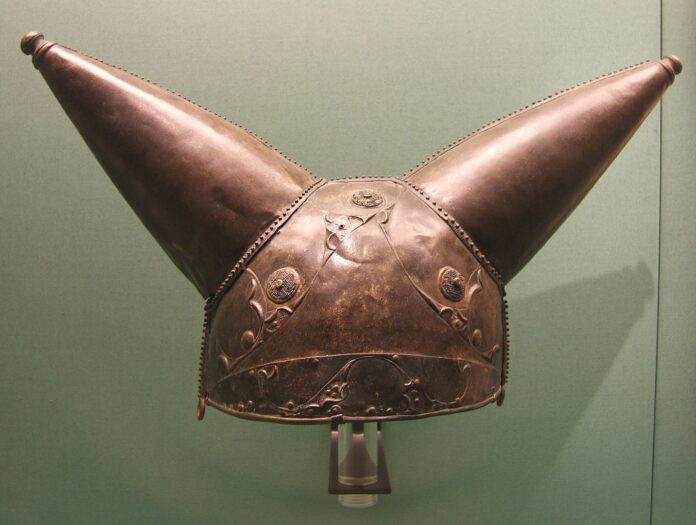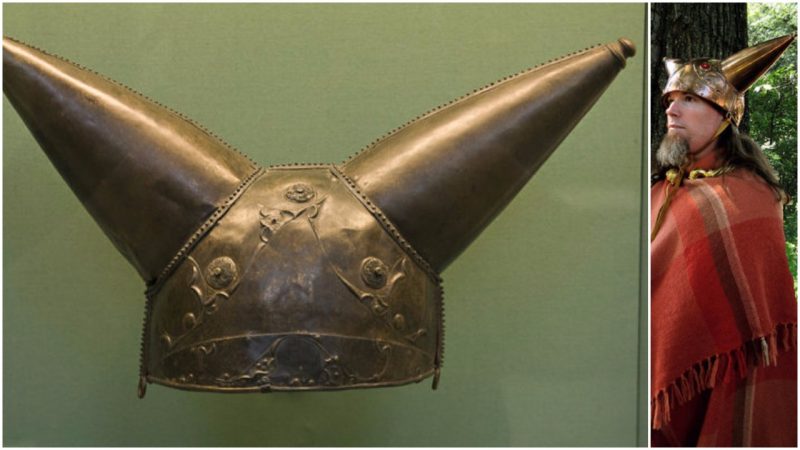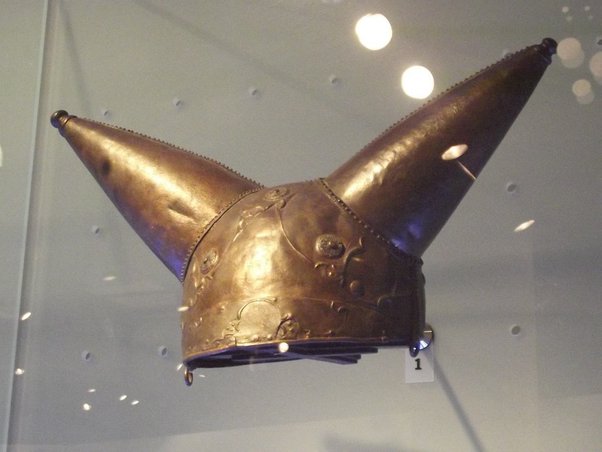Unearthing History: The Remarkable Discovery of the 2000-Year-Old Waterloo Helmet

In 1868, an extraordinary artifact was unearthed from the River Thames by the Port of London Authority. This discovery was none other than an ancient Celtic bronze helmet, now famously known as the Waterloo Helmet. This ceremonial helmet, dating back to the Iron Age, is one of only three such helmets ever found in England, and it stands out as the only horned helmet from that period discovered in Europe.
The Discovery and Design of the Waterloo Helmet

The Waterloo Helmet was found near Waterloo Bridge and is a masterpiece of La Tène art, a style popular in Britain during the last few centuries BC. Crafted from two pieces of bronze riveted together, the helmet features repoussé decorations, where designs are hammered into the reverse side of the metal. The most striking elements of the helmet are the two tapering horns, each tipped with terminal knobs, attached to the top. Additional rivets adorn the circumference and the points where the horns join the cap, adding to its intricate design.
Upon its discovery, the helmet exhibited a weathered blue-green patina typical of ancient bronze artifacts. However, it has since been restored to reveal a rich, polished bronze color, possibly further adorned with pieces of red glass. Small holes around the bottom edge suggest that the helmet may have originally had a lining.
Unique Among Iron Age Helmets

Including the Waterloo Helmet, only three Iron Age helmets have been found in England, with the other two being the Meyrick Helmet and the Canterbury Helmet. Unlike these other helmets, the Waterloo Helmet is the only one with horns. The horns on this helmet are straight and more reminiscent of a rabbit’s ears than the realistic bull horns typically associated with Gallic helmets.
The helmet’s unique design has been instrumental in helping archaeologists date the artifact. Iron Age representations of soldiers in horned helmets, such as those on the Gundestrup Cauldron from the 1st century BC and a bas-relief at Brague, France, provide valuable context. These depictions show figures with curved horns, which, like those on the Waterloo Helmet, are not sharply pointed.
Ceremonial Use and Significance

The thin sheets of bronze used to make the Waterloo Helmet indicate that it was not intended for combat. Instead, it was likely used for ceremonial purposes. Its small size suggests that it may have been designed for a statue or effigy, as it would not fit most fully grown men. It is also possible that the helmet was thrown into the River Thames as an offering of some type.
Modern Replication and Display

In 2014, Jeffrey Hildebrandt, a member of the Royal Oak Armoury and an experienced replicator of ancient helmets, successfully recreated the Waterloo Helmet. His journey, filled with both failures and successes, culminated in a reproduction that sold for $2,750.
Today, the original Waterloo Helmet is housed in the British Museum in London. Despite one horn being broken and replaced with a replica, the helmet is in remarkable condition considering it lay at the bottom of the River Thames for nearly 2,000 years. The helmet has also been part of significant exhibitions, including “Celts: Art and Identity” at the British Museum in 2015-2016, and a display at the National Museum of Scotland in Edinburgh from March to September 2016.
Conclusion
The Waterloo Helmet is a testament to the rich history and artistry of the Iron Age in Britain. As one of only three Iron Age helmets found in England, and the only horned helmet from that era discovered in Europe, it offers a unique glimpse into the ceremonial practices and artistic achievements of ancient Celtic culture. Its discovery and preservation allow us to continue to explore and understand the fascinating history of the Iron Age.
Video
News
The Hanging Temple: China’s 1,500-Year-Old Cliffside Marvel of Faith and Engineering
The Hanging Temple: China’s 1,500-Year-Old Cliffside Marvel of Faith and Engineering Perched precariously on the cliffs of Mount Heng in Shanxi Province, China, the Hanging Temple, also known as Xuankong Temple, Hengshan Hanging Temple, or Hanging Monastery, is an architectural…
The Willendorf Venus: A 30,000-Year-Old Masterpiece Reveals Astonishing Secrets
The Willendorf Venus: A 30,000-Year-Old Masterpiece Reveals Astonishing Secrets The “Willendorf Venus” stands as one of the most revered archaeological treasures from the Upper Paleolithic era. Discovered in 1908 by scientist Johann Veran near Willendorf, Austria, this small yet profound…
Unveiling the Maya: Hallucinogens and Rituals Beneath the Yucatán Ball Courts
Unveiling the Maya: Hallucinogens and Rituals Beneath the Yucatán Ball Courts New archaeological research has uncovered intriguing insights into the ritual practices of the ancient Maya civilization. The focus of this study is a ceremonial offering found beneath the sediment…
Uncovering the Oldest Agricultural Machine: The Threshing Sledge’s Neolithic Origins
Uncovering the Oldest Agricultural Machine: The Threshing Sledge’s Neolithic Origins The history of agricultural innovation is a fascinating journey that spans thousands of years, and one of the earliest known agricultural machines is the threshing sledge. Recently, a groundbreaking study…
Nara’s Ancient Sword: A 1,600-Year-Old Protector Against Evil Spirits
Nara’s Ancient Sword: A 1,600-Year-Old Protector Against Evil Spirits In a remarkable discovery that has captured the attention of archaeologists and historians alike, a 7.5-foot-long iron sword was unearthed from a 1,600-year-old burial mound in Nara, Japan. This oversized weapon,…
The Inflatable Plane, Dropped Behind the Lines for Downed Pilots
Experimental The Inflatable Plane, Dropped Behind the Lines for Downed Pilots The Inflatoplane from Goodyear was an unconventional aircraft developed by the Goodyear Aircraft Company, a branch of the renowned Goodyear Tire and Rubber Company, also famed for the Goodyear…
End of content
No more pages to load











